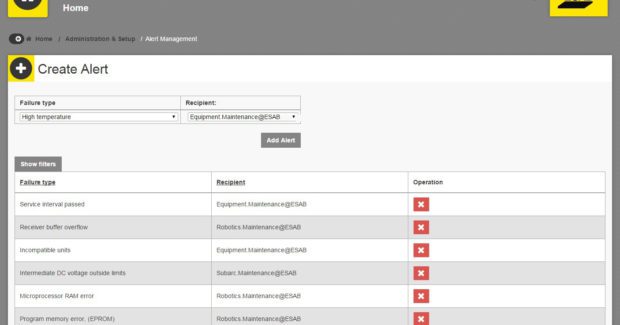A Week in the Life of An Online Data Management System
We can now measure, store and analyze up to 7.5 million weld sessions per day. By automating functions that were once done manually, a shop can save countless hours and provide real transparency into their drivers of productivity, quality and cost control.
Posted: May 9, 2016
Management guru Peter Drucker is often quoted as saying, “If you can’t measure it, you can’t manage it.” With the ability to measure, store and analyze up to 7.5 million weld sessions per day, online data management systems provide tools that enable shop managers to make quantum leaps in productivity, quality and cost control. A data management system consists of a communications module, either integrated with the system when purchased or installed as an aftermarket item. The module captures data for every weld session (arc start to stop), including arc-on time, welding parameters and faults and alarms.
Once captured, the module sends the data via Wi-Fi or LAN to a secured server (or even a laptop). Most fabricators prefer to use a server located inside their firewalls so that they can password-protect it, as well as use a computer that’s connected to their network. Running on top of the server is a suite of analytical and functionality tools. Historically, online data management systems could be difficult to deploy. But the next generation of systems can overcome many of the limitations. Here are a few attributes of easy-to-use systems:
- Setting up the communication module uses a procedure similar to that of configuring a wireless router, a task performed by the average homeowner.
- The software package deploys as easily as installing a new version of Microsoftâ Office and is capable of seamlessly integrate with ERP, PLM or MDM systems.
- The software and protocol are future-proof; many users prefer open-source vs. proprietary software.
- The system lets a shop start by connecting one welder to become familiar with the software and prove its value, and then easily scale up.
- Analytical and functionality tools function like apps on a smart phone, tablet or laptop. Ideally, users can configure a “dashboard” of the apps that are most specific to their needs.
- The system lets users connect remotely using the any device that can connect to the web (or to an intranet).
POWERFUL TOOLS
To showcase the power of online data management tools, let’s examine a hypothetical case of a fabricator with 20 welding stations in Houston and another 20 in Seattle, with all stations requiring a new welding program for the latest project. To start, the welding engineer uses the online data management system to push out the new weld procedure to each system. The entire process takes minutes. Previously, the welding engineer would have had to manually load the program on each machine with a USB stick. To start each shift, the welding operator scans his badge, which verifies that he has the required certifications. He then scans a code on the blueprints for the part at hand. The system automatically pulls in the appropriate weld schedules and acceptable limits. The operator would also scan the gas cylinder and wire spool for lot traceability and to ensure use of the correct consumables, as well as scan a bar code on the raw materials.
https://youtu.be/R63DEWagbV8
During welding, the system captures arc-on time and welding parameters. If at any point the system detects an error, incomplete data or parameters that are widely out of tolerance, it can create an alarm and even prevent the operator from striking an arc. While such a system might seem like overkill, consider that using the incorrect filler wire, welding parameters, procedures and parts are among the leading causes of weld defects/rejects. By identifying the exact source of the defect/reject, shops can rectify the situation faster.
Looking externally, the fabricator can provide complete traceability for every weld, now a requirement for structural steel construction, ship, offshore, pressure vessel, military, automotive, crane and other critical applications. Traceability previously required fabricators to manually enter data and generate reports. With automated data gathering, managers can generate reports in seconds. Further, automating data management eliminates the human tendency to manipulate data to “favorably enhance” the numbers. And lastly, electronic data gathering reduces paper use and associated storage space.
AUTOMATIC ALERTS
Now let’s jump to the middle of the week and explore some additional benefits of an online data management system. At this point, consumables have run low. But instead of manually taking inventory and figuring out how much to order, the system has automatically sent an email to the welding supply distributor. Because the MIG gun liners and drive rolls are becoming worn and could cause unplanned downtime, text messages alert the maintenance team that it’s time to install new consumables. Alerts, especially to mobile devices, greatly benefit people who work remotely, have already gone home for the night or are otherwise out of the office. Instead of running back to the factory, they can use remote diagnostic tools to initiate corrective action wherever they are.
The ability to work remotely also includes working with the system provider. For example, if the welding engineer suspected a program needed further enhancement, the system manufacturer could remotely examine the weld data in near-real time. The manufacturer could then develop an adjusted weld schedule and electronically send it to the engineer, solving the problem in hours instead of days.
WEEKLY REPORTS
It’s payday at the end of the week, and the shop uses an incentive plan tied to productivity (this is an actual case that we encountered when developing our WeldCloud system). By using productivity analytics, the company can reward operators who weld more parts. In addition, they can use quality analytics to ensure that the operators welded with the correct parameters (instead of increasing values so they could weld faster, which risks degrading mechanical properties). For a large enterprise, an online data management system provides visibility at macro and micro levels. Managers can look at data for each weld system, groups of systems, by facility or enterprise wide. If an app doesn’t exist for a particular metric, chances are that it can be developed.
Because web-based reporting speeds information flow, shops obtain a clearer picture of plant operation. They can eliminate equipment downtime, unscheduled maintenance and process bottlenecks, as well as improve overall equipment effectiveness, speed time-to-market and streamline schedules. While results vary, companies who deploy cloud-based solutions often experience significant ROI in six to 12 months.








